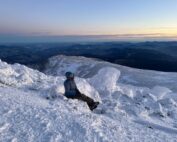So Close, Yet So Far Away
2016-11-15 17:40:53.000 – Ryan Knapp, Weather Observer/Staff Meteorologist
We take safety very seriously up on the summit. While the nearest hospital is only about 15 miles as the raven flies, unlike the ravens that soar around the summit, we don’t have the ability to fly this distance to immediately to receive help. Given our weather up here, it is uncommon to even get a helicopter up here. So the reality of it is, if we or anyone gets injured and needs to be evacuated, we are either going to be carried down by foot or taken down by vehicle – neither of which are as fast as I think people think they are.
Let’s start with the best case scenario – minor injury requiring little assessment and stabilization. There is a vehicle on the summit. It is the middle of summer with clear skies, calm winds, and temperatures well above freezing. And the road is clear of vehicles. So this scenarios would equate to: a minimum of 15 minutes for assessment and stabilization and loading into the vehicle+30-45 minutes driving to RT 16+30 to 40 minutes to the nearest hospital. So best case scenario, it takes close to an hour and a half to get someone down to the ER.
When you start to add in different scenarios, time starts to add up. Worst injury = more time for assessment and stabilization. Foggy conditions (which is over 60% of the year) = more time. Rain = more time. Snow/ice (yes, we can still get snow/ice, even in summer months) = more time. No vehicle on the summit = easily 3 hours extra (an hour to get someone to the base, 30 minutes up, 45 down to base, 45 minutes to hospital). Offsite injury = more time to assess, stabilize, and carry up. So, even in the dead of summer, an injury requiring evacuation can take several hours.
Since we are heading into winter, lets play out the best case scenario for winter – minor injury requiring little assessment and stabilization. The weather is clear with calm winds and temperatures near 0F. The road was traveled earlier in the day, so it requires little to no blading to level it off. And we have a snow tractor already up here for shift change. So this scenario equates to: 15 minutes for assessment and stabilization + 60 to 90 minutes back to the base (top speed is around 8 mph on an 8 mile road, but we rarely push it to top speed) + 30 to 45 minutes to the nearest hospital. So best case scenario during winter months would be somewhere between 2 to 3 hours after the initial injury.
Lets play that scenario again but this time without a snowcat already on the summit. While assessing, we get the operator of a snow tractor to come up since we do not keep them parked on the summit. Since it is going to take time to get a vehicle coming up here, I will neglect the assessment and stabilization phase as a separate time as that would be done while we waited. So this scenario equates to: 1 hour to contact a snowcat operator and for them to gear up properly and drive to the base + 30 to 60 minutes to get the snowcat warmed up and all the checks done for it to be ready to travel + 60 to 90 minutes up (top speed is around 8 mph on an 8 mile road, but we rarely push it to top speed) + 60 to 90 minutes back to the base + 30 to 45 minutes to the nearest hospital. So best case scenario during winter months would be somewhere between 5 to 6 hours after the initial injury.
Like last time, when you start to add in different scenarios, time starts to add up quickly Worst injury = more time for assessment and stabilization. Foggy conditions (which is over 60% of the year) = more time. Snow = more time. Blowing snow = more time. Offsite injury = more time to assess, stabilize, and carry up. With all this in mind, an evacuation can take well over 6 hours and can start to get upwards of 12 hours or more. And this isn’t even factoring in the worst case scenario when weather doesn’t allow for a vehicle to come up and/or for SAR teams to go out and search for a person. If that is the case, the injured party could be waiting in pain for upwards of 24 hours or more.
With all these scenarios simmering in the back of my head, I take everything I do very seriously up here. And this isn’t just limited to the weather outside. It can be something as simple as slipping on a wet floor indoors that would cause these scenarios to play out even. But even with all of these in mind, I am not going to curl up in a ball and rock myself silly; and neither should you. However, prior to putting yourself at risk, there are ways to avoid most scenarios altogether. Check a forecast prior to heading up (like our Higher Summits Forecast) so you know the weather to expect, pack the proper equipment (this list from Eastern Mountain Sports can get you started) for the weather expected, and packing some first aid equipment can go a long way. Lastly, if you get to a point on the trail where it gets to foggy, icy, etc, turn around. While we might be “right there”, if trouble arises, as you can see through these scenarios, we are nowhere near the facilities you might desperately need. You’re shortest route to safety in almost every scenario is down, not up.

Ryan Knapp, Weather Observer/Staff Meteorologist




